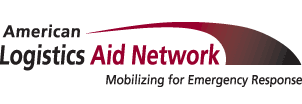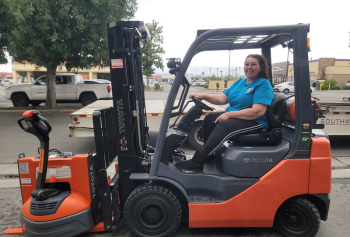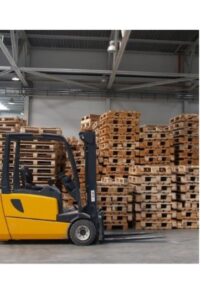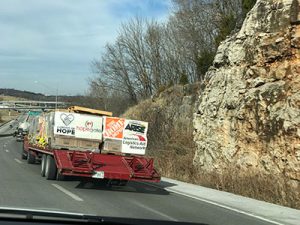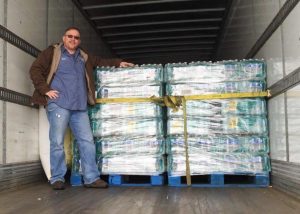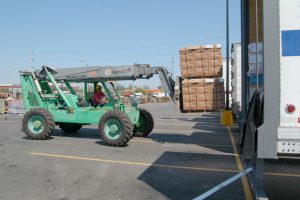Think you can’t make a substantial contribution to disaster relief because you’re not a doctor, EMT or first responder? Think again. In this exclusive article, ALAN’s Communications Director, Lori Lockman, explains why being able to share a piece of material handling equipment may be one of the most important superpowers of all.
As a kid, I loved magazines that published brain teasers – including this one, which temporarily stopped nine-year-old-me in my tracks.
Is this a picture of a beautiful girl or an old woman?
Before you answer allow me to pose a similar question to you: What do you see when you look at the photo below?
If you’re like some companies, it may seem like you’re simply looking at a forklift.
But look again – because if you’re like ALAN, you also should see a potential game-changer for humanitarian efforts.
The Logistics Of Hurricanes
To explain why, consider what happens during a “typical” hurricane.
Even before a named storm makes landfall in a particular place, non-profits that specialize in disaster relief are working hard to stage things like food, water, tarps and other essentials nearby so relief activities can commence quickly once the danger has passed.
After landfall, these groups are equally busy loading those same items onto trucks for forward movement to intermediate holding areas. Then, once items arrive at their final destinations (temporary shelters, places where mass feeding operations are occurring, mobile clinics, etc.), there’s usually a significant amount of receiving and on-site reshuffling required before goods can be used.
Meanwhile, many of the affected area’s local non-profits, like food banks, are also experiencing a massive surge in demand – and working hard to quickly serve a larger group of clients who have suddenly found themselves in need.
And that just covers what’s happening during the initial post-storm days and weeks!
Black Swan Events, Big Supply Chain Challenges
Or think about the many supply chain challenges that non-profits faced after the pandemic hit.
Some like Connecticut’s Filling in the Blanks (which supplements kids’ free school breakfasts and lunches via weekend food donations) suddenly found themselves being called upon to serve clients seven days a week, a huge uptick that put a massive strain on their already busy warehousing operations.
Others, like church-based relief organizations, had to create pop-up distribution operations in unlikely places like parking lots because their usual distribution sites like schools, fellowship halls and donation storefronts were closed. Meanwhile most of the supplies they were distributing were still arriving fully palletized.
Plus many businesses like sporting arenas and performing arts venues wound up making huge but unexpected donations of perishable food because they weren’t going to be able to use the food soon enough. The only catch was that the non-profits who were receiving these donations had to be able to figure out how to quickly receive, store and distribute them.
Ordinary Times, Extraordinary Warehousing And Distribution Requirements
Finally, look at the logistical hurdles that many humanitarian organizations have to deal with every day – regardless of whether or not there’s been a recent disaster.
From animal shelters and groups that assist people with disabilities to causes that help with poverty relief, most non-profits find themselves routinely needing to sift, sort through and share mountains of materials. And while some of the largest ones are fortunate enough to have top-notch logistics operations, many of the smaller- to medium-sized ones have basic facilities at best – a fact that makes each day an uphill distribution battle.
The Fork In The (Donation) Road
Can the many activities I’ve described above (and the similar ones that take place after tornadoes, earthquakes, snowstorms and fires) happen without the use of material handling equipment? Sometimes, if they absolutely have to. However I probably don’t have to tell you that they can be performed much more quickly and efficiently if forklifts, pallet jacks or other force enablers are part of the equation.
Which is where you and your organization come in.
If you’re replacing a piece of material handling equipment that still has some useful life left in it and would be willing to pass it along to a compassionate organization instead of reselling it – or better yet, if you have a new piece of MHE you’d be willing to donate – let us know. Chances are good we can help you find a good home for it in no time flat.
By the same token, if you have a forklift, pallet jack or other device you’d be willing to lend for a short period of time please consider offering it up. After disasters, such short-term donations are exactly the kind of thing that non-profits on the ground urgently need.
Just as important, even if you don’t have a piece of equipment to spare – but do have trucking space you’d be willing to contribute in order to transport a contributed forklift or pallet jack to its new, non-profit home, give us a shout, because finding a way to get donated equipment from Point A to B is another logistical challenge that we and our many humanitarian partners repeatedly face.
Finally, just for grins, drop us a line to let us know what you saw when you looked at the original picture – because there’s still a huge debate going on at ALAN, and we could use your help to break the tie. (For the record, I’m “team beautiful girl.”)
On behalf of all of us at ALAN thank you for being part of such a generous community. Large or small, your MHE and financial donations are a major reason why we’ve been able to show up and offer help for so many disasters – and enable help, hope and healing to arrive faster.
Lori Lockman
Communications Director
American Logistics Aid Network
